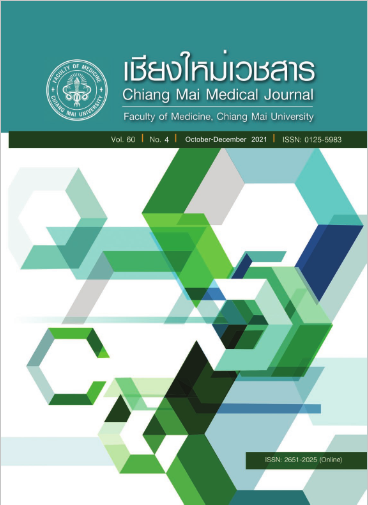Accuracy of Thai National Triage Guideline and Trauma and Injury Severity Score (TRISS) for predicting survival outcome in emergency department injured patients
Main Article Content
Abstract
Objectives Thailand uses the Ministry of Public Health’s Emergency Department Triage (MOPH ED Triage) triage system to triage injured patients; however there is inadequate evidence on its accuracy. Concurrently, the Trauma Injury and Injury Severity Score (TRISS) is a widely accepted and evidence backed scale used to predict survival outcomes of injured patients. Our study aims to validate the accuracy of MOPH ED triage in predicting survival outcome and the accuracy of MOPH ED triage compared to TRISS.
Methods We conducted a retrospective cohort study collecting data on 7,966 injured patients presenting to Sawanpracharak Hospital between January 1, 2020 and December 31, 2020. The accuracy of MOPH ED triage and TRISS were assessed using areas under the curve (AUC) and accuracy analysis of diagnostic tests.
Results MOPH ED triage and TRISS were both accurate in predicting survival outcome of injured patients; the AUC of MOPH ED Triage was 0.822 95%CI [0.741-0.903] and AUC of TRISS was 0.908 95%CI [0.860-0.956], with TRISS having a statistically significantly higher accuracy compared to MOPH ED triage, p-value 0.001.
Conclusions Both Thai National Triage Guideline and TRISS can accurately predict survival outcomes in injured patients. Therefore, Survival outcomes and TRISS could be used as a tool to evaluate the accuracy of triage in injured patients.
Article Details

This work is licensed under a Creative Commons Attribution-NonCommercial-NoDerivatives 4.0 International License.
References
Sawanpracharak Hopital. Annual reports 2020. Nakhonsawan: Sawanpracharak Hospital; 2020. (in Thai)
Ministry of Public Health, Strategy and Planning Division. Public Health Statistics A.D. 2019. Nonthaburi: Strategy and Planning Division; 2020. p. 26-38 (in Thai)
World Health Organization. World health statistics 2020: monitoring health for the SDGs, sustainable development goals: The organization; 2020.
Williams NC, Kardon M, Ceci KT, Zahn C, editors. Emergency Severity Index; A triage tool for emergency department care. Version 4: United States of America: Emergency Nurses Association; 2020
Ministry of Public Health, Department of Medical Services. MOPH ED Triage. Nonthaburi: Department of Medical Services; 2018. (in Thai)
Boyd CR, Tolson MA, Copes WS. Evaluating trauma care: the TRISS method. Trauma Score and the Injury Severity Score. J Trauma. 1987;27:370-8.
Bouzat P, Legrand R, Gillois P, Ageron FX, Brun J, Savary D, et al. Prediction of intra-hospital mortality after severe trauma: Which pre-hospital score is the most accurate? Injury. 2016;47:14–8.
Ministry of Public Health, Injury surveillance team. manual for data collection provincial injury surveillance. 5th ed. Nonthaburi: Division of Non Communicable Diseases; 2017. (in Thai)
moph.go.th [Internet]. Thailand: Health KPI: Mortality rate in injured patients [internet]. [cited 2021 Aug 17]. Available from: http://healthkpi.moph.go.th/kpi/kpi-list/view/?id=722 (in Thai)
moph.go.th [Internet]. Thailand: Health KPI: Mortality rate in injured patients with PS more than 0.5; c - [cited 2021 Aug 17]. Available from: http://healthkpi.dms.go.th/kpi2/kpi-list/view/?id=1802 (in Thai)
Raita Y, Goto T, Faridi MK, Brown DFM, Camargo CA, Hasegawa K. Emergency department triage prediction of clinical outcomes using machine learning models. Crit Care. 2019;23: 1-13.
Saisingthong H, Wittayachamnankul B. Correlation between Canadian Triage And Acuity Scale (CTAS) implementation and early outcome of patients in emergency department, Maharaj Nakorn Chiang Mai Hospital. Chiang Mai: Health Systems Research Institute. 2014;8:320-8. (in Thai)
Sian-in T, Joraluck J. The modified rapid emergency medicine score: A trauma triage tool to predict in-hospital mortality in Hatyai hospital. TJEM [Internet]. 2021;3:58-0. [cited 2021 Aug 17]. Available from: https://he02.tci-thaijo.org/index.php/TJEM/article/view/249082 (in Thai)
Hosseinpour R, Barghi A, Mehrabi S, Salaminia S, Tobeh P. Prognosis of the trauma patients according to the Trauma and Injury Severity Score (TRISS); a diagnostic accuracy study. Bull Emerg Trauma. 2020;8:148–55.
Levin S, Toerper M, Hamrock E, Hinson JS, Barnes S, Gardner H, et al. Machine-learning-based electronic triage more accurately differentiates patients with respect to clinical outcomes compared with the emergency severity index. Ann Emerg Med. 2017;71:1-10
Spangler D, Edmark L, Winblad U, Colldén-Benneck J, Borg H, Blomberg H. Using trigger tools to identify triage errors by ambulance dispatch nurses in Sweden: an observational study. BMJ Open. 2020;10:1-8
Zachariasse JM, Hagen V Van Der, Seiger N, Mackway-jones K, Veen M Van, Moll HA. Performance of triage systems in emergency care: a systematic review and meta-analysis. BMJ Open. 2019;9:1-9.


